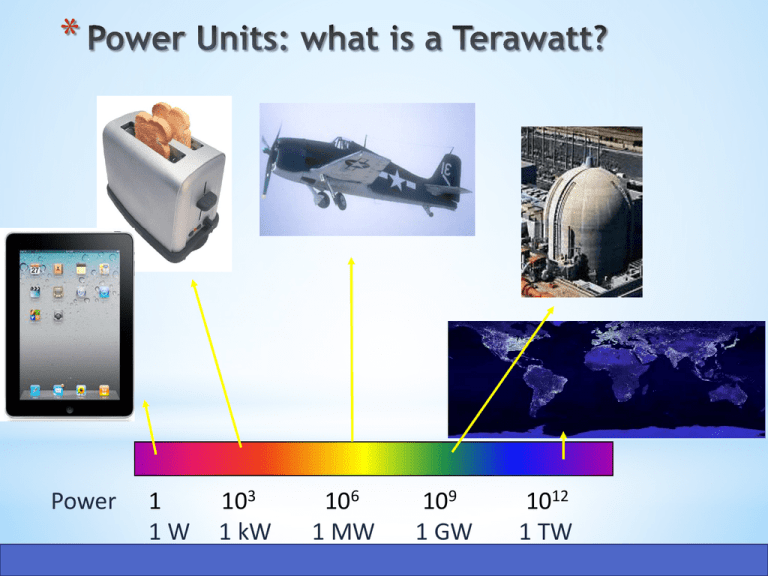Peak Oil: The global economy is based on Fossil Fuels
advertisement

* Power kWh/day 1 103 1 W 1 kW 0.03 24 106 1 MW 24,000 109 1 GW 1012 1 TW MacKay’s Book Principal unit * David MacKay’s 2009 book has become the resource for simplifying and demystifying the energy crisis. * Book uses numbers – and you should not be afraid to too! * “Foreign-language stuff” kept to the technical chapters at end of book/ “Intended to be accessible to everyone who can add, multiply and divide … especially aimed at our dear elected and unelected representatives…” 5 4.66 4.5 4 3.5 2.89 2.98 3 TW 2.5 2 1.24 1.5 0.92 1 0.285 0.5 0.286 0 Oil Coal Gas Biomass Hydro Nuclear Renew Total: 13.2 TW U.S.: 3.2 TW Get most accurate current numbers from www.eia.gov * Energy fuels economic growth * Cheap energy defines where we live, how we live our lives, food we eat … (Rubin paints a grim picture for the supply of “fresh” salmon!) * Most of our current energy comes from burning fossil fuels principally OIL * Standard economic theory: supply and demand? * But what happens when oil price spike? * What happens when supply can no longer meet demand? * Oil comes from creatures the size of a pinhead. These onecelled creatures, known as diatoms, aren't really plants, but share one very important characteristic with them - they take light from the sun and convert it into energy. * Paleontological Research Institution * Mixture of different hydrocarbons, CmHn Hydrocarbon Paraffins (alkanes) Avg. Range 30% 15 to 60% Naphthenes (cycloalkanes) 49% 30 to 60% Aromatics 15% 3 to 30% Asphaltics 6% remainder n-octane * A little chemistry: * 2 C8H18(l) + 25 O2(g) → 16 CO2(g) + 18 H2O(g) + 10.86 MJ/mol (of iso-octane) mass of iso-octane: 8*12+18 = 114 g/mol Simple compounds energy density (MJ/kg) Fossil fuels energy density (MJ/kg) carbon (to CO2) carbon (to CO) ethanol hydrogen methane methanol octane propane 32.8 22.7 29.7 142 55.5 22.7 47.9 50.3 coal, anthracite coal, bituminous coal, sub-bituminous coal, lignite diesel gasoline, automotive oil, crude (petroleum) kerosene 31.4 > 23.9 17.4–23.8 < 17.43 45.3 45.8 41.9 46.3 Foods energy density (MJ/kg) Biomass fuels energy density (MJ/kg) carbohydrates fats proteins 17.2 38.9 17.2 biomass f alfalfa straw Dry cowdung Water at 100m dam height Lithium Ion rechargeable battery (cell phone, laptop) Alkaline battery (AA cell) Uranium (nuclear fission) 0.001 MJ/kg ~0.7 MJ/kg ~0.6 MJ/kg 20,000,000 MJ/kg Source: The Physics Hypertextbook 18.4 15.5 (20 TJ/kg) * Rubin, Why your world is about to get a whole lot smaller 1. How long do you expect to live? 2. Do you expect oil to be powering most transportation for the next 30 years? 3. Do you expect multination wars to be waged with the aim to control regional oil resources? 4. Do you expect oil to be drilled and refined throughout over your lifetime? 5. Do you think we will run out of oil over your lifetime? Gorelick, Oil Panic and the global crisis “The peaking of world oil production presents the US and the world with an unprecedented risk management problem. As peaking is approached, liquid fuel prices and price volatility will increase dramatically, and without timely mitigation, the economic, social and political costs will be unprecedented.” Hirsch report, US Dept. of Energy (2005) “Thirty years from now there will be a huge amount of oil - and no buyers…. The stone age came to an end, not because we had a lack of stones, and the oil age will come to an end not because we have a lack of oil” Sheik Yamani, Saudi Oil Minister, 2000 Science, 109, 103 (1949) Based on 1956 data and using his model, Hubbert predicted peak US oil production between 1965 – 1971. His employer, Shell, dissociated itself from his forecast! How good is model? US peak was 1970 Gorelick (2010) * To make forecast, he needed historical data (to get initial slope) and an estimate of the oil endowment. Changing the latter estimate by factor of 2 only moves peak by < 20 years. * Hubbert extended his model to global oil depletion. Depending on estimate of global oil endowment (1.35 – 2.1 trillion) predicts peak global oil between 1995 – 2000. * Using a 2000 re-estimate of global oil endowment, peak would be in 2005. * Oil company and economists differ on whether we have already hit peak oil, but estimates only spread by about 10-20 years. * Gorelick (2010) Peak Oil *Individual oil wells, oil fields, whole countries production, or worldwide production should follow Hubbert’s Bell curve. Peak and decline at a similar rate to the rate of increase before the peak. *Peak in oil discoveries was 1965 *Peak US oil production 1970 *Peak world production (various estimates) Gorelick (2010) 2005 – 2020 * Will Peak Oil become Peak GDP for the United States? (Rubin) * Oil consumers Number of net exporters will fall form 35 in present decade to between 12-28 by 2030 After 1970, US became net importer of oil. Since 1970 the US (and UK) has invested heavily to maintain stable oil supply by foreign intervention and military depolyment to protect Middle East Oil Oil producers * How much oil does the US military consume compared to the amount secured from foreign intervention? * Gorelick (2010) Estimates place the political and military cost of maintaining oil supply to the US as $55 billion per year. Standing armed force cost alone is worth $65 /barrel of oil. * Current price of oil is $115/barrel * * The world will become much smaller (Rubin) * Human ingenuity: renewables will fill the gap * Look harder for fossil fuels – Energy Independence *











